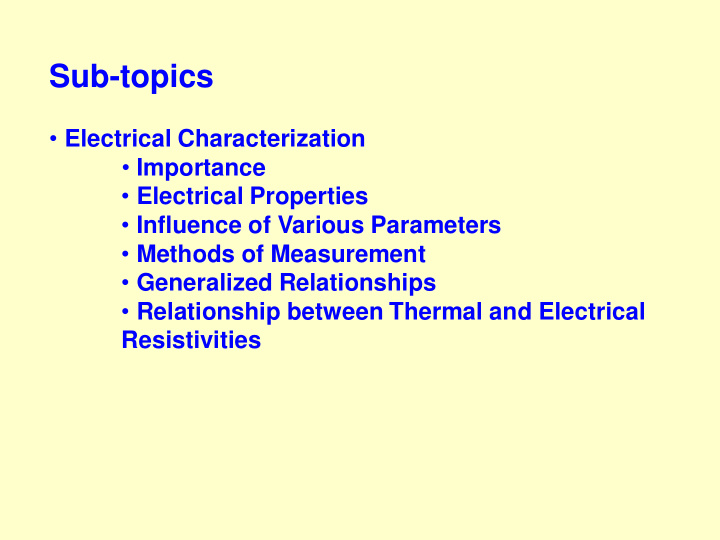



Sub-topics • Electrical Characterization • Importance • Electrical Properties • Influence of Various Parameters • Methods of Measurement • Generalized Relationships • Relationship between Thermal and Electrical Resistivities
Importance of Electrical Properties of Geomaterials In Geotechnical Engineering Becoming essential for predicting/determining: Water content & Saturation Degree of compaction Porosity Hydraulic conductivity Liquefaction potential of the soil mass Detecting and locating geomembrane failures To estimate corrosive effects of soil on buried steel/concrete To investigate effects of soil freezing on buried structures Estimating soil salinity for agricultural activities.
Importance….. Change in water content leads to change in the dielectric permittivity of the water-geomaterial system or vice versa. This fact leads to determination of water content of the geomaterial if its dielectric constant is known. Many sensing techniques have been developed, over years and are still being developed for measuring soil moisture and some of these techniques are: Capacitance probe/FD Sensor Time domain reflectometry, TDR, probe Useful for rapid determination of in-situ moisture content that too under non-invasive and non-destructive manner. Measure volumetric moisture content. Water has a high dielectric permittivity (=81, which is more than an order of magnitude greater than that of the soils and geomaterials, dry soil= 3). For air, dielectric permittivity= 1.
Geomaterial Characterization Using Electrical Properties (EP) EP of geomaterials are their response to applied electric field Electrical resistivity for a material is ρ Dielectric constant for a material is defined as: k = ε s / ε o
Geomaterial Characterization Using Electrical Properties Electrical Resistivity ( ) Dielectric constant (k) METHODS • Low frequency resistivity methods (<100 Hz) • High frequency dielectric methods (10 4 -10 9 Hz) ADVANTAGES OVER OTHER METHODS: • Non destructive • Fast and easy • Incorporate response of the micro-structure (of the soil mass)
Parameters influencing Electrical Properties of Geomaterials • Porosity and the pore structure • Water content • Salinity level • Cation exchange capacity of the soil • Temperature • Type and Frequency of the current Parameters influencing Liquefaction of soils • Grain shape and size • Porosity & Relative Density • Variation of Water table • External Forces/Disturbances---shearing • Resistivity = f (void ratio)=f (density) • Change in resistivity= f (change in the void ratio) = f (change in the density)
Parameters Influencing Electrical conductivity The conduction of electricity in geomaterials takes place through the moisture-filled pores. Therefore, EC of the soil is influenced by the interactions between the following soil parameters: Pore continuity: Water-filled pores that are connected directly with the neighbouring pores tend to conduct electricity more readily. Soils with high clay content have numerous, small water-filled pores that are quite continuous and usually conduct electricity better than sandy soils. Compaction normally increases the pore continuity and hence the soil EC. Water content: Dry soil conductivity is less than the moist soils.
Salinity level: Increase in concentration of electrolytes (salts) in pore solution will increase the EC appreciably. Cation exchange capacity (CEC): Mineral soils containing high levels of organic matter (humus) and/or minerals such as Montmorillonite, Illite or Vermiculite have a much higher ability to retain positively charged ions (such as Ca, Mg, K, Na, NH 4 , H) than soils lacking these constituents. The presence of these ions in the pores enhances EC in the same way that salinity does. Temperature: As temperature decreases, towards the freezing point of water, EC decreases slightly. Below freezing point, pores become increasingly insulated from each other and overall EC declines rapidly.
Frequency Capacitance, Inductance and Resistance are strongly dependent on the frequency of the current input. Capacitance is the property of an electric circuit that opposes any change in voltage and is dependent on the frequency. Water (due to its dipole nature) in the pores is largely responsible for the residual high-frequency capacitance. It varies from a high value, at low frequency, to a low value, at high frequency. Capacitance values at high frequency correspond to the background capacitance of the water in the medium. An inductor is a electronic component that stores energy in the form of a magnetic field. Inductance is the property of an electric circuit that opposes current. However, in most of the geomaterials (unless they contain Iron) this component is not significant. Resistance is the opposition to the flow of current in an electric circuit and it decreases rapidly with the increase of frequency.
The type of current used plays an important role: DC and low frequency AC (<100Hz) are employed for determination of soil resistivity. For frequency >100 Hz, the conductivity is noticed to increase with the applied frequency. On the other hand, high frequency (>1MHz) dielectric response of geomaterials can be employed to characterize the soil fabric structure such as: particle shape, Size, orientation and porosity These studies highlight the presence of water (dielectric constant 81) in increasing the dielectric constant of the wet soil as compared to its dry state (dielectric constant 5). The dielectric constant is noticed to remain constant only if the applied frequency is >50 MHz. TDR and capacitive devices are employed for finding the dielectric constant of the geomaterials based on which its characterization can be done.
Recommend
More recommend